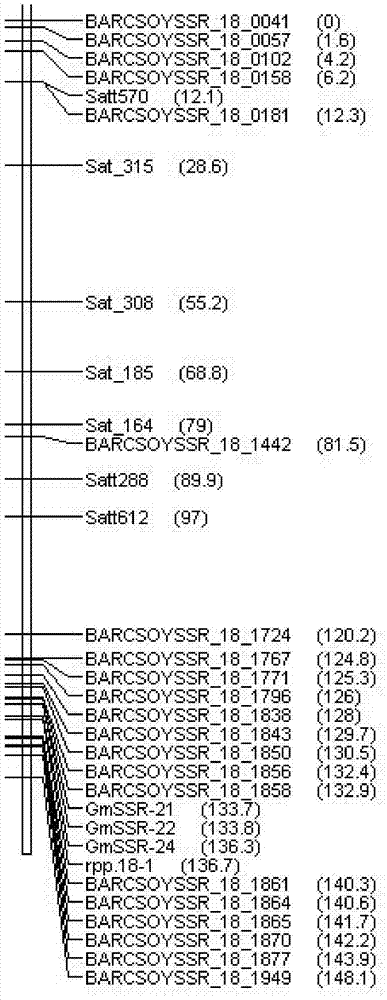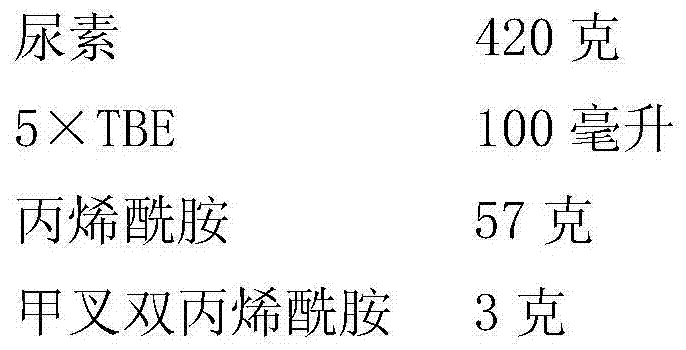Molecular marker GmSSR18-24 closely linked with soybean rust resistance gene and application
A technology for soybean resistance to rust and rust, which is applied in the determination/inspection of microorganisms, DNA/RNA fragments, recombinant DNA technology, etc., can solve the problem of no disease-resistant varieties and control methods, accelerate the reproduction rate of pathogenic fungi, and reduce soybean yield losses. and other problems, to achieve the effect of convenient and rapid detection methods, speeding up the breeding process, and saving production costs
- Summary
- Abstract
- Description
- Claims
- Application Information
AI Technical Summary
Problems solved by technology
Method used
Image
Examples
Embodiment 1
[0033] Example 1. Using the primer pair GmSSR18-24 to identify the F of Zhongdou 40×SX6907 2 Individual plant resistance to rust
[0034] 1. PCR reagents for identification or auxiliary identification of soybean rust resistance
[0035] The PCR reagents for identification or auxiliary identification of soybean rust resistance in this embodiment consist of PCR primer pair GmSSR18-24, 10×Taq buffer, dNTP mixture, MgCl 2 solution, Taq DNA polymerase and ddH 2 O composition.
[0036] Among them, the PCR primer pair GmSSR18-24 consists of two single-stranded DNAs, a forward primer and a reverse primer, and its sequence is as follows:
[0037] Forward primer: 5'-GAAGAGGGTCTTCAAAAATCAATC-3' (SEQ ID NO: 1),
[0038] Reverse primer: 5'-TTGTTAATCAGGATCTATAAGACATTG-3' (SEQ ID NO: 2).
[0039] 2. Soybeans to be identified
[0040] Zhongdou 40×SX6907 F 2 The segregation population is obtained as follows: Zhongdou 40 and SX6907 are crossed, and the hybrid offspring are self-crossed, wh...
Embodiment 2
[0107] Embodiment 2, the acquisition of primer pair GmSSR18-24
[0108] The segregating population used was a non-rust-resistant soybean variety Zhongdou 40 crossed with rust-resistant soybean SX6907 (Shan Zhihui et al., Screening and identification of a new source of resistance to soybean rust, Chinese Journal of Oil Crops, 2012, 34: 188-192), F 2 A total of 116 individual plants were isolated from the population.
[0109] to F 2 The 116 individual plants were analyzed by SSR molecular markers to obtain genotype data, and the genetic map was constructed using Joinmap 3.0, combined with the identification data of rust resistance inoculation, and the rust resistance gene was mapped using WinQTL cartographer 2.5, and the soybean resistance to rust was mapped on soybean chromosome 18. The rust gene locus rpp.18-1 belongs to complete dominant inheritance.
[0110] Wherein, DNA extraction, PCR amplification, and electrophoresis are the same as those in Example 1 above.
[0111]...
PUM
 Login to View More
Login to View More Abstract
Description
Claims
Application Information
 Login to View More
Login to View More - R&D
- Intellectual Property
- Life Sciences
- Materials
- Tech Scout
- Unparalleled Data Quality
- Higher Quality Content
- 60% Fewer Hallucinations
Browse by: Latest US Patents, China's latest patents, Technical Efficacy Thesaurus, Application Domain, Technology Topic, Popular Technical Reports.
© 2025 PatSnap. All rights reserved.Legal|Privacy policy|Modern Slavery Act Transparency Statement|Sitemap|About US| Contact US: help@patsnap.com



